It’s easy to get discouraged about the state of the world today. But these stirring environmental reads raise awareness about the environment and reveal steps all of us can take to be part of the solution. They also offer a much-needed shot of optimism, telling us that there’s still time to save our planet, so long as we act now.
12 Urgent and Inspiring Environmental Books
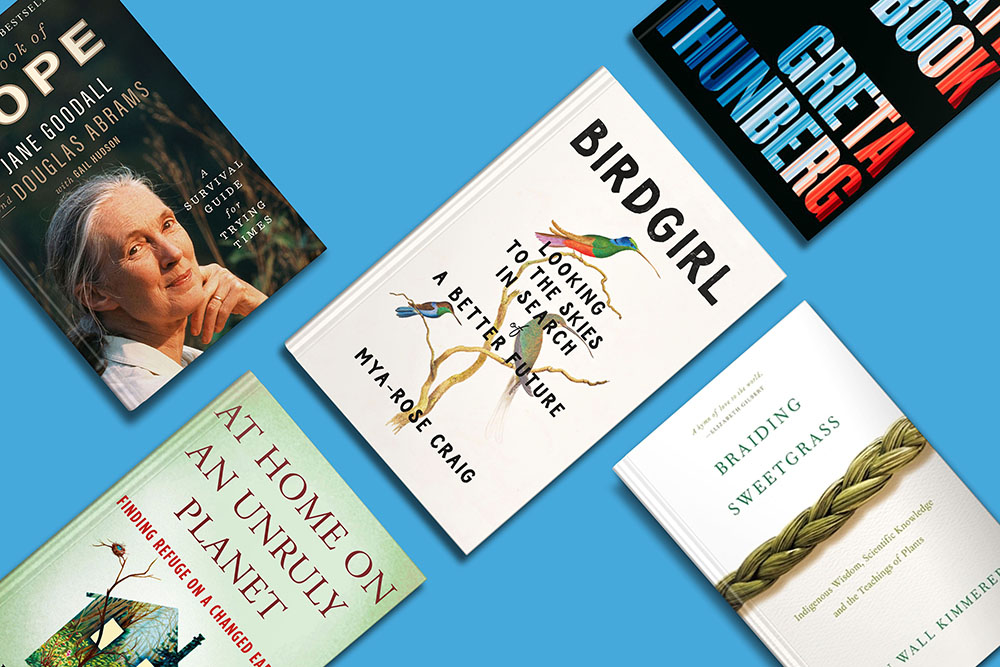
These eye-opening narratives will inspire you to act.
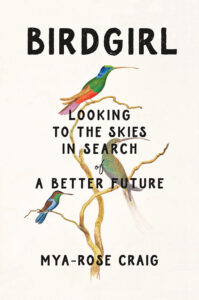
Birdgirl: Looking to the Skies in Search of a Better Future
By Mya-Rose Craig
At just 21 years old, Mya-Rose Craig is a world-renowned ornithologist, environmental activist, and social justice leader who has received an honorary doctorate from Bristol University in England for her work. In her extraordinary memoir, Craig shares her story of traveling the globe with her family to study rare birds and document Earth’s grandeur and fragility. Craig also chronicles her mother’s mental health struggles and relates how the natural world provided solace and direction in the midst of her personal crisis. “An excellent mix of travelogue, memoir, and advocacy” (Kirkus, starred review), Birdgirl demonstrates the singular benefits of connecting with nature and the global importance of fighting for environmental and racial justice.

The Book of Hope: A Survival Guide for Trying Times
By Jane Goodall
In the face of an uncertain present, Jane Goodall and Douglas Abrams encourage us to choose hope instead of fear. In this instant New York Times bestseller, acclaimed naturalist Jane Goodall uses the power of storytelling and connection to illustrate her “Four Reasons for Hope” for a brighter future. Across its pages, Goodall reveals the key moments from her career that shaped her into the messenger of hope she is today and channels her experiences into invaluable lessons all of us can use to build a better world. A stirring read that is as insightful as it is instructive, The Book of Hope champions nature’s dignity and the indomitability of the human spirit.
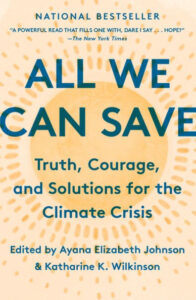
All We Can Save: Truth, Courage, and Solutions for the Climate Crisis
By Ayana Johnson and Katharine K. Wilkinson
Curated by two leading climate activists, this bestselling environmental book collects an array of illuminating essays written by women at the forefront of the environmental movement. All too often, women and girls are left out of conversations about climate change, sustainability, and environmental conservation. Here, we get to hear their voices and learn from their expertise. Spanning a range of perspectives and enriched with poetry and art, All We Can Save offers robust solutions to reshaping the world and addressing the climate crisis.

The Climate Book
By Greta Thunberg
If you’re reading this list, chances are good that you’re familiar with Greta Thunberg and her inspiring story. In The Climate Book, Thunberg presents 84 impactful chapters that lay out the facts of climate change and offer a step-by-step path to action. Thunberg’s compelling narrative is stacked with hard data and eye-opening scientific research. Equally important, however, is the fact that Thunberg channels the works of philosophers, historians, and Indigenous leaders to answer deeper questions about fighting for our planet’s future. You’ll find graphs and datasets alongside art and photography in this acclaimed new book about the environment, illuminating the stark realities of ecological catastrophe and what we must do to stop it.

At Home on an Unruly Planet: Finding Refuge on a Changed Earth
By Madeline Ostrander
Resilience and empathy are crucial tools in the fight to save the planet — and this lyrical narrative has both in abundance. In At Home on an Unruly Planet, science journalist Madeline Ostrander chronicles the unfolding climate crisis through reports of people struggling to protect their homes from wildfires, rising sea levels, and fossil fuel disasters. Ostrander pairs these harrowing accounts with a clear call for optimism and action, arguing that “home” is not a solitary place but a shared practice of creation and preservation to which we all must commit.

Waste: One Woman’s Fight Against America’s Dirty Secret
By Catherine Coleman Flowers
In this searing environmental memoir grounded in civil rights and local activism, MacArthur grant–winning author Catherine Coleman Flowers shows us the shocking state of sanitation in rural America. Flowers grew up in Lowndes County, Alabama, just outside Montgomery. In the 1960s, Lowndes County stood at the center of the Civil Rights movement. Today it faces a new struggle: equal access to basic sanitation. Flowers reveals how decades of class prejudice and racial inequality have led to appalling wastewater conditions in disenfranchised communities across the country, from Alabama and the Florida coast to central California, Alaska, and the urban centers of the Midwest. As the climate crisis intensifies, substandard sanitation issues compound, imperiling our planet and our neighbors. A “powerful and moving book” (Booklist), Waste draws a clear line between racial and environmental justice, arguing that our fight to save the planet must include the fight for our most vulnerable communities.
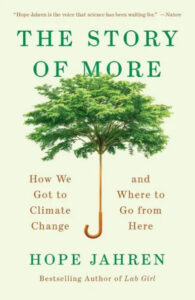
The Story of More: How We Got to Climate Change and Where to Go from Here
By Hope Jahren
In this insightful and accessible book about the environment, award-winning scientist Hope Jahren explores the ecological upsides and downsides of some of humanity’s greatest scientific achievements. Jahren guides us through an array of world-changing inventions and breakthroughs, from cars and electricity to large-scale farming, and presents the impact of each on society and the planet. The author reveals that it’s not necessarily one industry over another that’s destroying the environment but our collective push for growth at any cost and our insatiable consumption habits — the desire for more. Looking to the past and projecting into the future, The Story of More delivers a necessary assessment of the dangers of consumption and offers a much-needed road map to living with less.
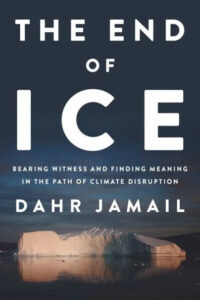
The End of Ice: Bearing Witness and Finding Meaning in the Path of Climate Disruption
By Dahr Jamail
In The End of Ice, Dahr Jamail encourages us to reckon head-on with grief and loss if we hope to move forward. A war reporter by trade, Jamail spent years overseas before returning to Alaska to rekindle his love of hiking and mountaineering. Upon his return, however, Jamail discovered that the snowy slopes and peaks he once explored were now irreversibly altered by climate change. The author’s grief spurred a journey around the world to document our wounded planet and mourn what we’ve lost, from melting glaciers in the Bering Sea to bleached coral in the Great Barrier Reef to clear-cut swaths of the Amazon rain forest. In bearing witness to environmental degradation, The End of Ice advocates for cherishing our planet and protecting what remains.

Rising: Dispatches from the New American Shore
By Elizabeth Rush
The climate crisis is unfolding before our eyes. Hurricanes, flooding, and fires have upended millions of lives, and more people are put at risk daily. In this award-winning nonfiction narrative, which was a finalist for the Pulitzer Prize, Elizabeth Rush calls on us to view environmental preservation not as a crusade to save our future selves but as a rescue mission for those who need help now. To make her case, Rush brings readers to some of the most imperiled locations in the United States, from the Gulf Coast to the Bay Area to New York City, where people are having to choose between staying in place and risking their lives or leaving their homes forever. By putting a face to the crisis and centering those who are all too often pushed to the margins, Rising shows us what we’ll endure if we don’t make changes now.
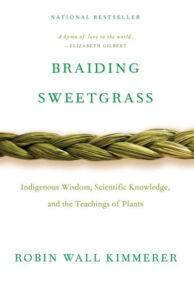
Braiding Sweetgrass: Indigenous Wisdom, Scientific Knowledge, and the Teachings of Plants
By Robin Wall Kimmerer
In this beloved and bestselling environmental book, Indigenous botanist Robin Wall Kimmerer reminds us that the battle for our planet’s future cannot succeed without honoring our personal relationship to nature. Kimmerer draws on Western science and the traditions of her Potawatomi ancestors to craft this moving account of climate change, spirituality, botany, and environmental stewardship. Braiding Sweetgrass warns us that humanity’s tendency to separate civilization from nature obscures our symbiotic relationship with plants and animals. Instead, we must embrace this shared bond and give ourselves fully to protecting the Earth that sustains us.

How to Give Up Plastic: A Guide to Changing the World, One Plastic Bottle at a Time
By Will McCallum
This is the perfect book if you’re looking to live a greener lifestyle. In How to Give Up Plastic, Greenpeace activist Will McCallum offers a clear-eyed explainer for eliminating plastic from your life. Throughout this actionable book, the author shows you how to spot plastic in your home and gives excellent tips on eco-friendly alternatives. Even better, McCallum teaches you how to engage with businesses in your community and to advocate for sustainable practices across the country.
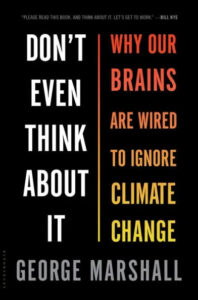
Don’t Even Think About It: Why Our Brains Are Wired to Ignore Climate Change
By George Marshall
One of the biggest challenges to environmental advocacy is overcoming a stubborn reality of human behavior: namely, that we have a habit of ignoring certain threats. In Don’t Even Think About It, George Marshall examines humanity’s scattershot response to the environmental crisis, asking why, in the face of irrefutable evidence, we still struggle to agree and work together to implement obvious solutions. Marshall argues that while we have no one but ourselves to blame, our humanity also holds the key to turning inaction into action; it’s our shared love of storytelling, fear of death, and instinct to protect our families that just might see us through. Combining in-depth research with compelling personal narratives, Don’t Even Think About It shows us how we can make our shared humanity work for us rather than against us in the struggle to save the environment.
Share with your friends
Related Articles
Celadon delivered
Subscribe to get articles about writing, adding to your TBR pile, and simply content we feel is worth sharing. And yes, also sign up to be the first to hear about giveaways, our acquisitions, and exclusives!
Celadon delivered
"*" indicates required fields


